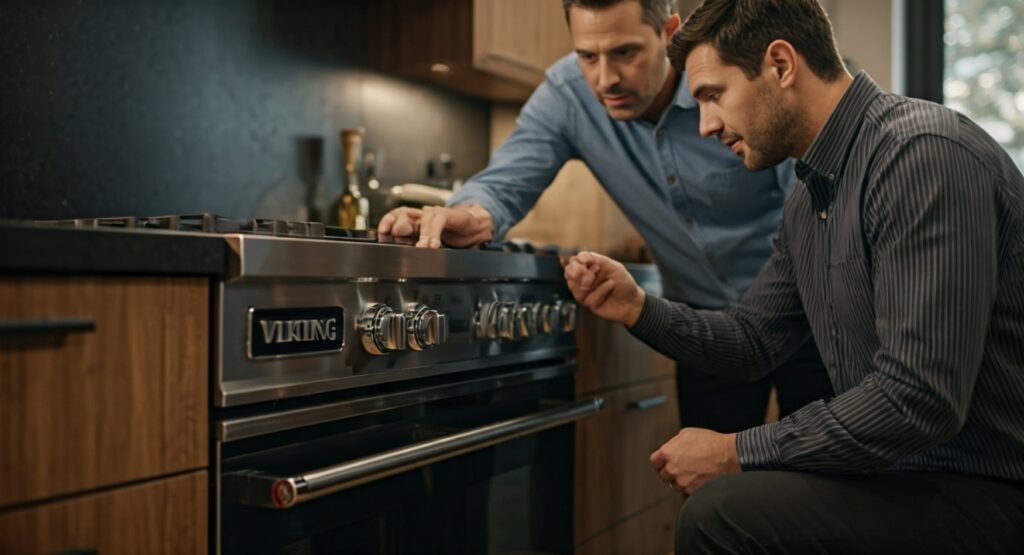Wildfires cause a lot of damage, and this can affect our homes as well. Wildfire ash is a light, powdery substance that can get into many small spaces. This can be bad for our health and for our appliances. This issue is important for Viking stoves. These stoves are known for their quality and performance. They need careful cleaning after a wildfire. In this guide, you will learn how to safely clean your stove after wildfire.
Understanding Wildfire Ash and Its Impact on Appliances
The tiny particles in wildfire ash can be like sandpaper. They can scratch the smooth surface of your stovetop, especially if you clean it the wrong way. These scratches can make your Viking stove look bad. They can also trap bacteria and dirt, making it harder to keep clean over time.
For gas stoves, ash can be a big problem. It can clog the burner ports. This can cause flames to burn unevenly and lower heat output. It might even create a gas leak hazard. The sensitive parts of gas valves can also get affected, which might need expensive repairs.
Electric stoves can also suffer from wildfire ash. When ash builds up on heating elements, it can insulate them. This makes it harder for them to transfer heat. It affects cooking times and can lead to overheating or damage to the heating elements.
Preparing to Clean Your Stove Safely
Before cleaning your Viking stove after exposure to wildfire ash, prioritize your safety. Wildfire ash can harm you if you breathe it in or if it touches your skin. So, it’s very important to take the right steps to protect yourself while you clean.
Safety Gear and Tools You Will Need
Protecting yourself is very important when cleaning up wildfire ash. Before you start, make sure you have the right safety gear and tools:
- Gloves: Wear thick rubber gloves to keep your hands safe from ash and cleaning solutions.
- Mask: Use a NIOSH-certified N95 or P100 mask to stop you from breathing in ash particles.
- Eye protection: Safety glasses or goggles will protect your eyes from any flying debris.
In addition to safety gear, get these cleaning supplies ready:
- Shop vacuum with HEPA filter: This is useful for picking up loose ash from the stovetop and nearby areas.
- Bucket of warm water: Prepare a bucket with warm water to rinse off cloths and sponges.
- Dish soap: Use a gentle dish soap so it doesn’t hurt the finish of the stove.
- Soft cloths and sponges: Pick non-abrasive cloths and sponges to avoid scratches.
- Plastic scraper: A plastic scraper can help take off tough ash stuck in place.
Having these items ready will make cleaning safer and easier.
Initial Steps Before Cleaning Begins
Preparation is important for cleaning well. Before you start, follow these key steps:
- First, unplug your Viking stove or turn off the gas valve if it is a gas stove. This keeps you safe from electrical shocks or gas leaks while you clean.
- Next, open the windows and doors in your kitchen. This helps remove any ash from the air and brings in fresh air while you work. It also reduces the chance of breathing in harmful substances.
- If you can, pull your stove away from the wall. This way, you can reach all sides and the space around it easily. This makes cleaning simpler and helps you find any hidden ash that might be stuck behind or under the stove.
Detailed Cleaning Guide for Different Types of Stoves
The way you clean your Viking stove will change a bit based on whether it is gas or electric. Knowing these differences helps you clean safely and effectively, matching your stove’s design and parts.
The sections below give you a clear, step-by-step guide to clean both gas and electric stoves after they have ash on them. Always remember to follow safety steps and wear the right gear while you clean.
Cleaning Gas Stoves After Ash Exposure
Gas stoves have many parts that need special care when you clean them after ashes collect. Start by taking off the burner grates, caps, and heads. Check your stove’s manual if you need help with how to remove these parts.
Use a soft brush and warm, soapy water to carefully clean the grates, caps, and burner heads. Make sure to clean out the burner ports well, so nothing is stuck in them. Rinse everything with clean water and dry them off completely before putting them back together.
To clean the top of the stove, use a damp cloth with warm, soapy water to wipe off the ash. Don’t scrub too hard, as this could hurt the finish. If there are any tough ash spots, make a paste with baking soda and water. Put this paste on the spots and let it sit for a few minutes. Then, gently wipe it away with a damp cloth.
Cleaning Electric Stoves After Ash Exposure
Cleaning an electric stove after it gets ash on it is different from cleaning a gas stove. This is because there are electrical parts involved.
- First, use a damp cloth with warm, soapy water to wipe the whole stovetop.
- Make sure to keep moisture away from the heating parts and control panel.
- Then, focus on the heating elements while the stove is unplugged.
- Take a soft brush and lightly clean any ash off the coils. Be careful not to bend or harm the heating parts while doing this.
- If your electric stove has a smooth glass top, do not use harsh cleaners or scrubbers. These can scratch the glass.
- Use a cleaner meant for glass cooktops along with a soft cloth or sponge for the best clean and shine.
Addressing Ash in Oven Interiors
Wildfire ash can get into your oven. This can mess with how it works and may contaminate your food. To fix this, first remove any loose ash inside the oven. Use a shop vacuum with a HEPA filter for this.
Then, make a mix of equal parts water and white vinegar in a spray bottle. Lightly spray the inside of the oven, including the door, walls, and racks. Let it sit for a few minutes. This helps to loosen any tough ash leftover.
Next, take a damp cloth or sponge and wipe the inside clean. Rinse your cloth often with clean water. If you see hard stains, make a paste with baking soda and water. Apply it, let it stay for a few minutes, and then wipe it away. Finally, make sure the oven is completely dry before you use it again.
Special Considerations and Tips
When you are cleaning your Viking stove after it gets dirty from wildfire ash, there are some things to remember. Ash is very fine and can easily fly into the air. So, it’s important to wear a mask.
Also, be careful not to use too much water, especially near electrical parts. If you notice any strange damage or if your stove does not work right after cleaning, contact a qualified technician right away for help.
Dealing with Stubborn Ash and Soot Deposits
While a deep cleaning can get rid of most ash and soot, some tough spots might need more effort. Here are some tips for dealing with stubborn dirt:
- Baking soda paste: If there is thick residue, mix baking soda with a little water to make a paste. Spread it on the dirty area and let it sit for a few minutes. After that, gently scrub with a soft sponge.
- Commercial oven cleaner: If things are really tough, a commercial oven cleaner may be needed. Be sure to follow the directions and make sure the area is well-ventilated. Also, wear protective gear when using cleaners.
- Professional cleaning: If you find it hard to clean stubborn spots or feel unsure about using harsh cleaners, think about getting help from a professional cleaning service. They know how to clean your Viking stove safely and well without causing any damage.
Preventive Measures to Protect Stoves from Future Ash Damage
Prevention is better than a cure, especially when protecting your valuable appliances from wildfire ash damage. Taking some simple steps can save you time, effort, and money on repairs later.
- Cover your stove: When you’re not using your Viking stove, cover it with a clean sheet or a special stove cover. This small step keeps ash from settling on the surface and getting into hard-to-reach spots.
- Seal windows and doors: During a wildfire, ash can get into your home through the tiniest openings. Make sure your windows and doors are tightly closed to reduce ash getting in.
- Regular cleaning: If you live in an area at risk of wildfires, it’s important to clean more often. Try to wipe down your stovetop and clean the inside of your oven regularly, even if you haven’t used them. This stops ash from building up and makes it easier to clean up if a wildfire happens.
By following these steps, you can cut down the risk of ash damage and keep your Viking stove in great shape.
Maintenance and Care Post-Cleaning
Once you have cleaned your Viking stove carefully, it is important to keep it clean and working well. Taking these steps will help your stove last longer and work better for your cooking needs.
Check your Viking stove often for any damage or wear. Look closely at how the burners work, any gas connections (if there are any), and the state of electrical parts. Keeping an eye out for problems early can stop bigger issues and save you money on repairs later.
Inspecting for Damage and Functionality
After you clean your Viking stove, check it closely for any damage from the ashes or cleaning. Look for scratches, dents, or any color changes on the stovetop.
If you have a gas stove, watch the burner flames. They should always burn with a steady blue flame. If you see flickering or yellow flames, or smell something odd, you may have clogged burner ports or a gas leak. Get a skilled technician to help you right away.
Also, look at the oven seals for any damage or wear. Good seals help the oven heat up properly and keep the heat inside. If you see cracks or gaps, think about replacing them to keep your oven working well.
Routine Maintenance Tips to Extend Stove Life
Routine maintenance is important for your Viking stove to last longer and work better. By adding these easy steps to your cleaning routine, you can keep your stove looking good and running well for many years.
- Wipe down after each use: After cooking, use a damp cloth to wipe the stovetop and control panel. This will take away food spills, grease, or residue before they stick.
- Clean spills promptly: Clean up any spills or overflow right away. This helps to stop them from drying and becoming harder to clean.
- Schedule professional cleaning: For a really deep clean, think about getting a professional cleaning service for your Viking stove once a year or every six months, depending on how much you use it.
By spending some time on regular upkeep, you can enjoy a clean and efficient Viking stove for many meals to come.
Contact Us at Viking Appliance Repair Pros Today!
Dealing with what happens after a wildfire is tough. It’s even harder if your appliances are damaged. If you are unsure how to clean your Viking stove or have problems after cleaning, it’s important to get help from a professional. At Viking Appliance Repair Pros, we offer expert advice and trustworthy services. Our skilled technicians know how to handle appliance damage from wildfires. They can help make sure your Viking stove works like new again.
Conclusion
In conclusion, it is very important to know how to safely clean your stove after wildfire. This helps your stove work well and last longer. By using the right cleaning steps and protective measures from this guide, you can clear out ash and keep your stove safe from damage. Be sure to check for any problems and do regular maintenance to keep your stove in good shape. If you have more questions or need help, feel free to contact our experts at Viking Appliance Repair Pros. Stay aware and proactive in protecting your appliances for a strong home. For more appliance tips, check out our blog on Restoring Oven Doors with Natural Cleaners Post-Wildfire.
Frequently Asked Questions
What should I avoid doing while cleaning my stove post-wildfire?
When you clean your Viking stove after a wildfire, avoid using harsh chemicals, rough cleaners, or scrub pads. These can hurt the surface and spread small particles of wildfire ash. This can be bad for your stove and your health. Always choose gentle cleaning products and tools.
How often should I clean my stove if I live in a wildfire-prone area?
If you live near places that often have wildfires, you need to be careful when cleaning your Viking appliance. It’s important to wipe down the surfaces regularly. Even if you can’t see any ash, cleaning helps stop small particles from building up. This keeps your stove clean and safe to use.
Is it safe to use my stove immediately after cleaning it from ash contamination?
After you clean your Viking stove post-wildfire, make sure it is fully dry and has no cleaning solutions left. It is good to run the exhaust fan for a few minutes. This will help get rid of any small particles in the air before you use your Viking appliance for cooking.






